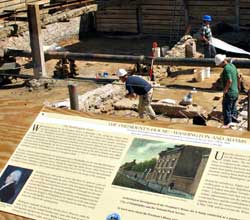Archaeological dig exposes racist U.S. history
By
Betsey Piette
Philadelphia
Published May 31, 2007 10:09 PM
Hidden below the modern skyscrapers lay the ruins of Philadelphia’s
history—the foundation of a city, and a nation, built and maintained by
the labor of enslaved Africans.
|
George Washington used a loophole
to keep Africans enslaved.
WW photos: Joe Piette
|
An excavation near the cracked Liberty Bell is laying bare the history of the
first “White House,” where George Washington resided in the 1790s
and kept nine enslaved Africans: Oney Judge, Moll, Austin, Hercules, Giles,
Paris, Richmond, Christopher Sheels and Joe. It is also providing strong
evidence to support the movement for reparations.
The excavation was planned to clear the site in order to lay the foundations
for a memorial pavilion to the presidential house and its occupants, including
the enslaved Africans. Intended to be completed in time for
Philadelphia’s upcoming annual July 4 extravaganza, reaction to the dig
may result in a change of plans as many people echo comments of an
African-American visitor who murmured, “They should leave this. The truth
is finally there to see.”
The first weekend the archaeological dig opened in mid-May, it drew over 1,000
visitors, stunning Park Service officials. A steady stream of visitors gathered
on a small elevated viewing platform for the opportunity to see the building
outlines and hear archaeologists explain what they were seeing. The tone was
almost solemn, the discussions serious about just what role slavery played in
the founding of the U.S.
The floor of the kitchen where Washington’s enslaved African chef
Hercules toiled is visible. The dig has uncovered new evidence that the kitchen
had a cellar and that an underground passageway connected it to the main
house.
The outline of a curving neoclassical window that would inspire the current
White House Blue Room and Oval Office lies close to the viewing platform. The
“important” visitors Washington received in front of this window,
however, could not look out onto the quarters of the enslaved Africans.
Archaeologists have uncovered the foundation of a wall they believe was built
to hide the slaves from public view. Washington was violating a Pennsylvania
law that entitled enslaved Africans to freedom after a six-month residency.
One of Philadelphia’s premier tourist attractions, Independence Hall, is
visible behind the dig. Other enslaved Africans, who were never compensated for
their labor, built Independence Hall.
That Washington and other early U.S. presidents kept slaves in Virginia has
never been denied. But when it was discovered about 30 years ago that he also
kept enslaved Africans in Philadelphia, the National Park Service buried the
discovery. To keep slaves in a free state, Washington exploited a loophole, by
periodically swapping his Philadelphia slaves with some of the 316 he kept in
Virginia. When some managed to escape, Washington relentlessly hunted them
down.
Historical archaeologist Cheryl Janifer LaRoche commented that the dig is
offering an opportunity to touch a past that’s been buried and walled
away. LaRoche explained the role played by influential financier Robert Morris
Jr., who moved from his mansion so it could be used as Washington’s
residence. Morris, a key delegate to the 1775 Constitutional Convention, was a
major slave merchant for 40 years as a partner in the Philadelphia mercantile
shipping firm Willing & Morris.
LaRoche, like many others, does not want to see this site covered over when the
Liberty Bell memorial is constructed. Michael Coard agreed with LaRouche.
“It would be a crime and a sin to bury this,” stated Coard, a
member of the memorial oversight committee and founder of Avenging the
Ancestors Coalition (ATAC).
Coard was recently honored by the Philadelphia City Council for his work that
compelled Independence National Historical Park to acknowledge the enslaved
Africans who lived and worked at this site. Coard is an activist lawyer who
also teaches a course on hip-hop culture at Temple University. He had launched
a letter-writing campaign and petition drive that evolved into ATAC, which
organized a 500-person demonstration on July 3, 2002, to demand that the Park
Service acknowledge Washington’s Philadelphia slaves.
Understanding past U.S. history is more critical than ever today, as the crisis
of capitalism is creating a new era of super-exploitation of labor around the
world. Billions of workers around the world receive less than $1 per day.
Millions at home are forced into a twenty-first century variety of slavery
behind prison walls. The fight for reparations necessitates digging up this
rotten system to the roots and burying it once and for all.
Articles copyright 1995-2012 Workers World.
Verbatim copying and distribution of this entire article is permitted in any medium without royalty provided this notice is preserved.
Workers World, 55 W. 17 St., NY, NY 10011
Email:
[email protected]
Subscribe
[email protected]
Support independent news
DONATE


